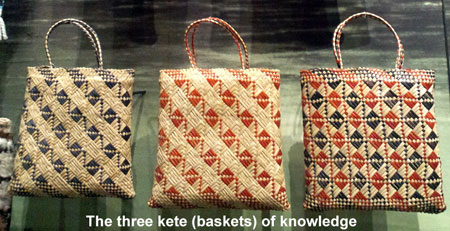By Peter Mellow, Learning Design Coordinator, Learning Environments, (The University of Melbourne).
Many people design learning activities for students in higher education; academics as well as professional staff are involved in preparing learning materials. We often build these activities from evidence based pedagogy, or our own past experiences in learning. But how often do we consider indigenous pedagogy in our design?
 I don’t claim to be an expert on indigenous pedagogy but I have studied it on both sides of the Tasman and spent the first 12 years of my life growing up three miles from a Maori epicentre of culture, Parihaka. Most New Zealand educators know of and use the three Kete (baskets) of knowledge (Aronui, Tuairu, and Tuaatea) legend.
I don’t claim to be an expert on indigenous pedagogy but I have studied it on both sides of the Tasman and spent the first 12 years of my life growing up three miles from a Maori epicentre of culture, Parihaka. Most New Zealand educators know of and use the three Kete (baskets) of knowledge (Aronui, Tuairu, and Tuaatea) legend.
There are many wise words to be found in indigenous learnings that are timeless and can be used to inspire, motivate and nurture learners. My favourite Maori proverb is:
He aha te mea nui o te ao? What is the most important thing in the world?
He tangata, he tangata, he tangata It is the people, it is the people, it is the people.
I use this often in my teaching to emphasise that our students need to be at the forefront of everything we do when designing learning activities, be it for a face-to-face, blended or online learning environment.
However, is adding an indigenous quote to a lesson, a Pōwhiri, or a welcome to country at the start of you class enough? Or is it just giving lip service or a nod to cultural awareness and integration?
In the last few years I have become more aware of Aboriginal pedagogy. The PhD of Tyson Yunkaporta is a rich document in this space (link). When I saw the ‘eight ways’ framework Tyson identified, I was happy to see that seven of them are components that I use regularly in my learning design.
- Story sharing
- Non-linear
- Community links
- Deconstruct – reconstruct
- Symbols and images
- Non-verbal
- Learning map
It was nice to know that I am including some indigenous perspectives into my design that are also strongly aligned to current teaching theory. Land links, the eighth way, is something that I currently don’t use enough, but will make an effort to include more in the future.
Speaking to a wise colleague about this recently, he pointed out to me that by integrating more indigenous elements into our education we may help all students on their learning journey by encouraging them to connect and become more grounded in the country they are studying in.
Our younger generations are sometimes struggling for a sense of belonging and identity, so weaving some indigenous components into the fabric of our learning design could assist. So, consider some indigenous pedagogy in the next learning activity you create for both recognition and inclusion.
Kete (basket) Photo By Yanajin33 (Own work) [CC BY-SA 3.0], via Wikimedia Commons.
Learning is a Journey poster from Teaching adults posters, Ako Aotearoa.


This great practical, applied research around online learning and indigenous students has just come out. Well worth reading.
Rethinking online learning design to enhance the experiences of Indigenous higher education students
Reedy, A. (2019). Rethinking online learning design to enhance the experiences of Indigenous higher education students. Australasian Journal of Educational Technology, 35(6), 132–149. https://doi.org/10.14742/ajet.5561
This great practical, applied research around online learning and indigenous students has just come out. Well worth reading.
Rethinking online learning design to enhance the experiences of Indigenous higher education students
Reedy, A. (2019). Rethinking online learning design to enhance the experiences of Indigenous higher education students. Australasian Journal of Educational Technology, 35(6), 132–149. https://doi.org/10.14742/ajet.5561
Since writing this post, I spoke with Robert Hogg, a colleague from one of my previous institutions and he told me that AUT is now working on “implementing Matauranga Maori into our curriculum.” A great goal that other institutions could follow up on. ✔️ ???????? ???? ????
http://www.aut.ac.nz/study-at-aut/study-areas/te-ara-poutama/research/research-expertise/mAtauranga-mAori